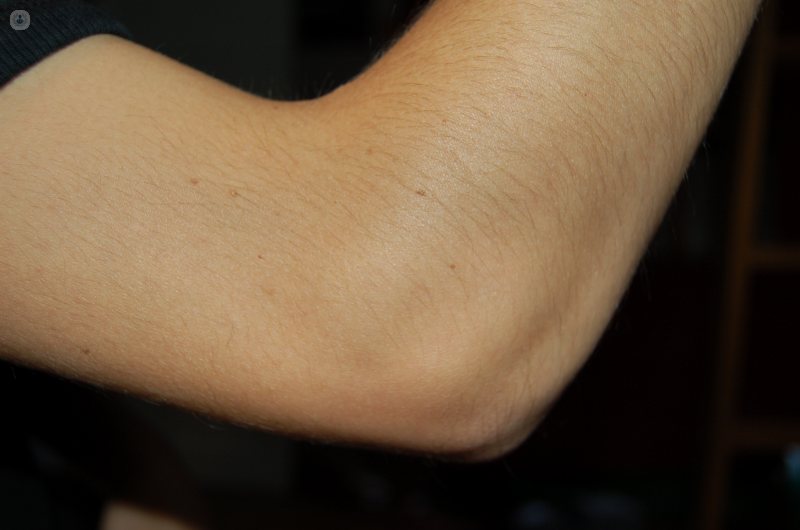

What is the elbow?
The elbow is the joint that joins the arm to the forearm, connecting the humerus with the proximal ends of the ulna and radius. It is formed of bone, cartilage, ligaments, and fluid. The muscles and tendons help stabilise the elbow when we move it. Trauma to any of these structures will cause problems in the elbow.
Function of the elbow
The elbow enables a series of movements for straightening and bending the arm. These include:
- Extension, using the triceps brachii muscles.
- Flexion, using the biceps brachii, brachialis and brachioradialis.
- Supination, using the short supinator muscle and biceps brachii.
- Pronation, using the round and the square pronator muscles.
Pathologies of the elbow
Many factors can cause pain in the elbow, whether injured or not. The most common of these are:
- Osteoarthritis. This a degenerative process that rarely affects the elbow. When it does occur, it is mainly caused by intense, continuous exercise or repetitive trauma.
- Arthritis. An inflammatory process that affects a joint, causing pain and an increase in temperature. Its causes are varied. In the elbow, the most common causes are: rheumatoid arthritis, psoriatic arthritis, infectious arthritis, gout and chondrocalcinosis.
- Epicondylitis, or tennis elbow, which causes pain on the outside of the elbow.
- Medial epicondylitis, or golfer’s elbow, which causes pain on the inside of the elbow.
- Olecranon bursitis, or student’s elbow. This is a rheumatic disease that affects the soft parts (not the bone) of the joint.
- Elbow luxation. Though this is less common than shoulder luxation because the surfaces of the bones fit together perfectly. The main cause is a fall onto an outstretched hand, and is usually associated with fracture.
- Painful pronation (babysitter's elbow or radial head subluxation). The head of the radius moves from its normal position, without completely dislocating, and is therefore referred to as subluxation. It is common in children under 5 years of age due to sudden traction on the forearm (e.g. when taking a child’s hand and pulling them to help them up steps, during physical contact sports such as judo, etc.).
- Fractures: Most fractures are of the lower or distal extremity of the humerus, the head of the radius and the olecranon of the ulna.
- Monteggia fracture. This is a complex and rare injury where luxation of the radial head at elbow level is associated with a fracture in the proximal third of the ulna.
- Terrible triad of the elbow. This is a severe injury that is usually caused by a fall onto an outstretched hand. This type of injury is usually accompanied by luxation, with a fracture of the radial dome and the coronoid process of the ulna. Treatment involves surgery.
Treatments for elbow pathologies
Treatment will depend on the cause of the problem. To diagnose any elbow injury, various tests need to be performed: direct arthrography, radiography and nuclear magnetic resonance imaging, among others. Once the diagnosis has been made, the specialist will decide how best to treat the elbow pathology in each case.
Normally, the main measure taken to treat the injured structure is to reduce inflammation, restrict mobility and alleviate pain, weakness and functional disability. This is why it is important, first of all, to administer NSAIDs (anti-inflammatory drugs), to put the arm in a sling, or similar, to limit mobility and to have physiotherapy. Physiotherapy will generally involve cryotherapy (application of cold), electrostimulation (TENS), a passive stretching programme for the pronation and supination muscles (those involved in twisting the forearm), wrist extensions and flexions, together with postural recommendations. Once the pain has subsided, exercises can be carried out to strengthen the muscles of the affected arm.
If the injury is more severe, the specialist may recommend other procedures. These may include elbow arthroplasty, surgery for tennis elbow or, if surgery is not recommended, injections into the joints and soft tissues.
Which specialist treats elbow pathologies?
Elbow pathologies are treated by an orthopaedic specialist. There are also orthopaedic surgeons who specialise in elbow problems and therapeutic treatments.

